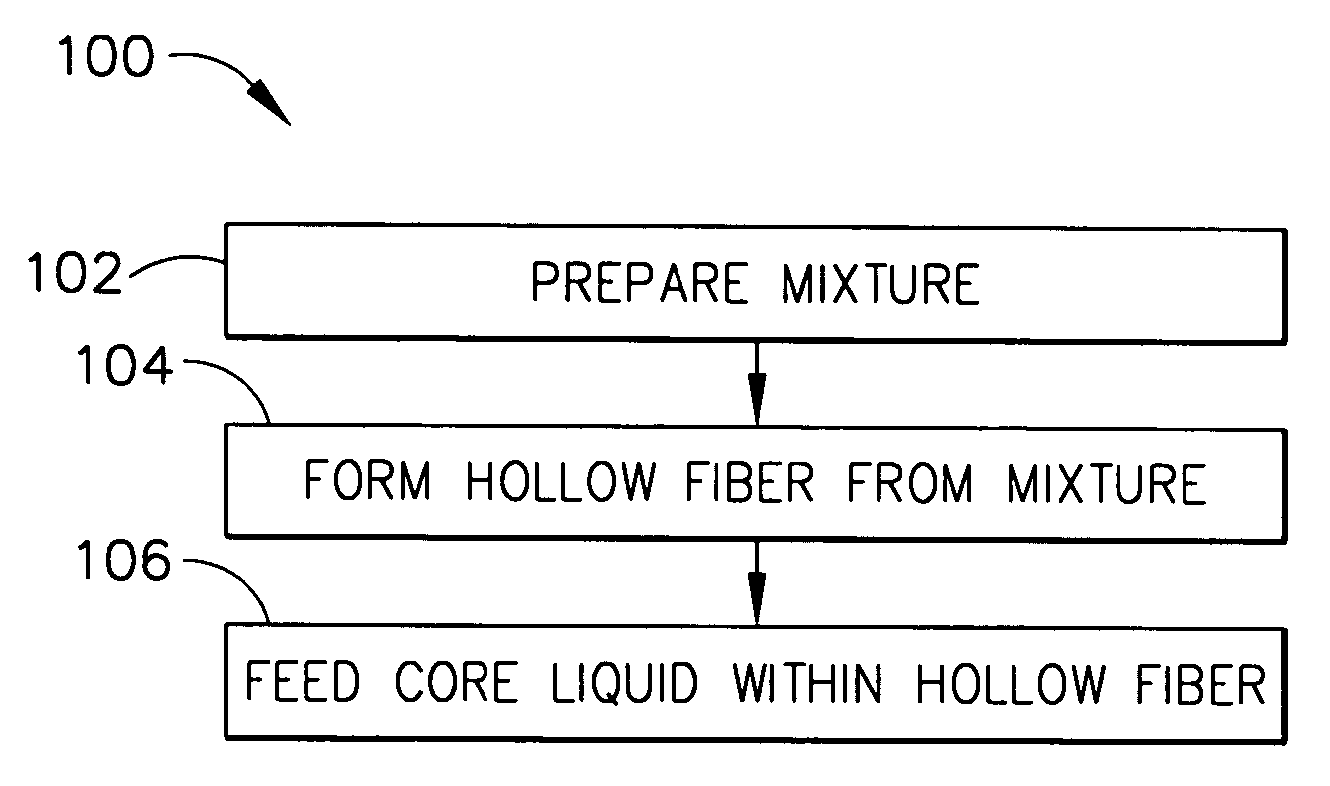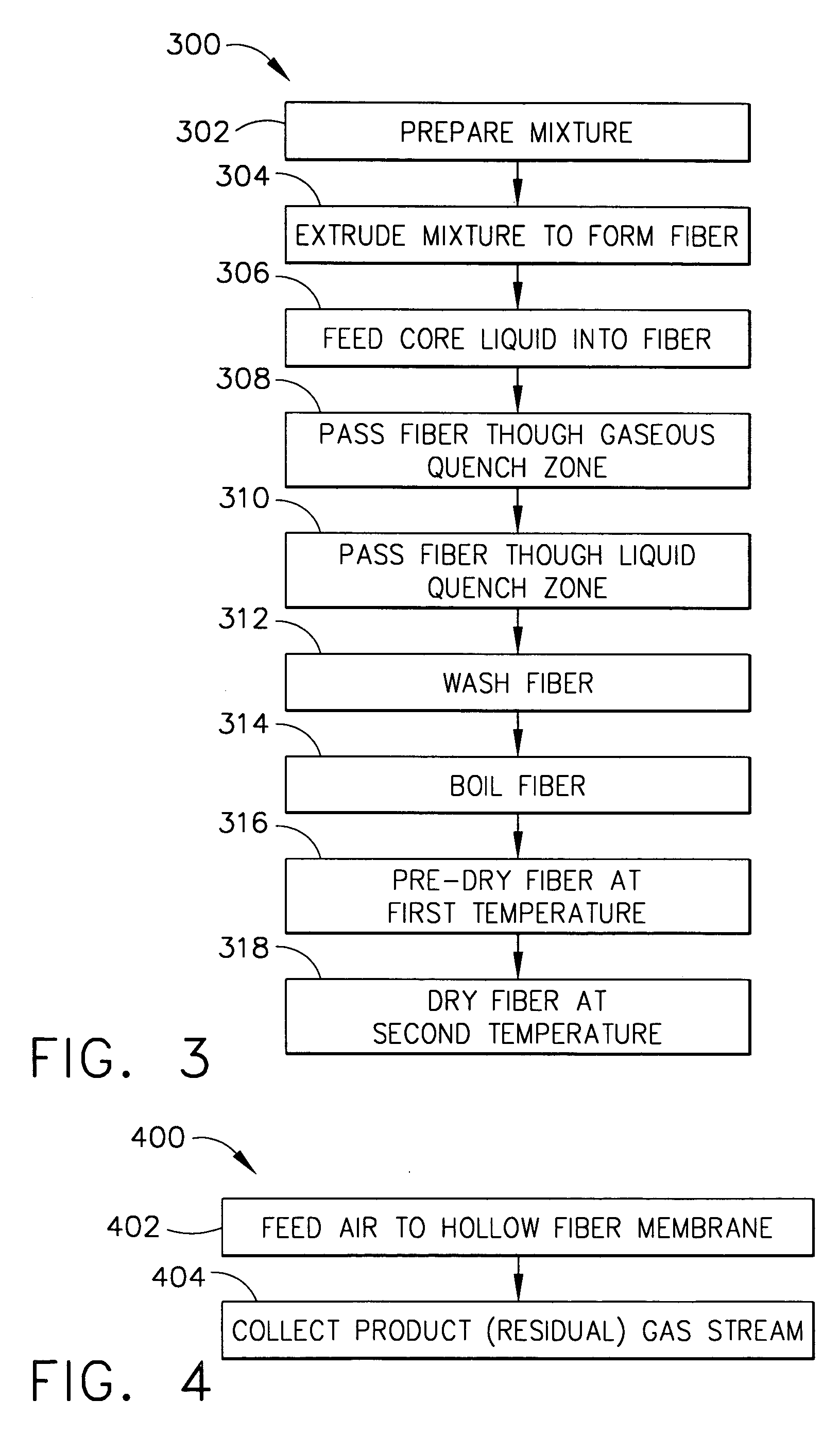High temperature gas separation membrane suitable for OBIGGS applications
a gas separation membrane and high temperature technology, applied in the field of gas separation membranes, can solve the problems of increasing the risk of fuel tank composition, flame propagation or explosion, and each of these approaches has proved costly to operate or is being eliminated
- Summary
- Abstract
- Description
- Claims
- Application Information
AI Technical Summary
Benefits of technology
Problems solved by technology
Method used
Image
Examples
example 1
[0056] A mixture of 30% by weight polyetherimide (PEI), 58.2% by weight N-methyl pyrrolidone (NMP, solvent), and 11.8% by weight ethanol (non-solvent), (solvent to non-solvent ratio of 4.9) was placed in a 500 ml plastic bottle and shaken at 100 rpm on a reciprocating shaker at 70° C. overnight. The mixture was then de-bubbled and extruded through a spinnerette at a rate of 1.9 g / min. The mixture was kept at 90° C. and the surface of the spinnerette was kept at 75° C. The mixture was extruded through an annulus (684 microns inside diameter and 1194 microns outside diameter) with a core fluid pin feeding a core liquid comprising 42% by weight NMP and 58% by weight ethanol at a rate of 0.9 ml / min. The line speed was 120 ft / min. The extruded hollow fiber was passed through an air quench zone having a height of 25 cm. at ambient temperature. The fiber was then passed through a liquid quench bath of ambient temperature tap water with a residence time of 2 seconds. The fiber was wound on ...
example 2
[0058] A mixture of 40% by weight polyetherimide (PEI), 47.4% by weight N-methyl pyrrolidone (NMP, solvent), and 12.6% by weight triethylene glycol (TEG, non-solvent), (solvent to non-solvent ratio of 3.8) was placed in a 2000 ml stirred reactor and stirred at 80° C. for 48 hours. The mixture was then de-bubbled and extruded through a spinnerette at a rate of 2.2 g / min. The mixture was kept at 90° C. and the surface of the spinnerette was kept at 97.5° C. The mixture was extruded through an annulus (684 microns inside diameter and 1194 microns outside diameter) with a core fluid pin feeding a core liquid comprising 50% by weight NMP and 50% by weight TEG at a rate of 1.0 ml / min. The line speed was 200 ft / min. (about 60 m / min.). The extruded hollow fiber was passed through an air quench zone having a height of 40 centimeters at ambient temperature. The fiber was then passed through a liquid quench bath of ambient temperature tap water with a residence time of 1.2 seconds. The fiber w...
example 3
[0060] A polyetherimide hollow fiber gas separation membrane prepared according to the instant invention (e.g., as described hereinabove with respect to FIGS. 1-3) was exposed to a temperature of 150° C., and the inlet flow rate, product flow rate, and permeate flow rate were recorded over time. On the date shown as 1 / 20 (FIG. 5A), the temperature was raised to 160° C., and thereafter the temperature was maintained at 160° C. The inlet flow rate, product flow rate, and permeate flow rate were essentially constant over the following 34 days. The results shown in FIG. 5A indicate that the hollow fiber of the instant invention is stable at temperatures of at least about 160° C.
PUM
| Property | Measurement | Unit |
|---|---|---|
| temperature | aaaaa | aaaaa |
| inside diameter | aaaaa | aaaaa |
| inside diameter | aaaaa | aaaaa |
Abstract
Description
Claims
Application Information
 Login to View More
Login to View More - R&D
- Intellectual Property
- Life Sciences
- Materials
- Tech Scout
- Unparalleled Data Quality
- Higher Quality Content
- 60% Fewer Hallucinations
Browse by: Latest US Patents, China's latest patents, Technical Efficacy Thesaurus, Application Domain, Technology Topic, Popular Technical Reports.
© 2025 PatSnap. All rights reserved.Legal|Privacy policy|Modern Slavery Act Transparency Statement|Sitemap|About US| Contact US: help@patsnap.com



